airbag VOLKSWAGEN TRANSPORTER 2021 User Guide
[x] Cancel search | Manufacturer: VOLKSWAGEN, Model Year: 2021, Model line: TRANSPORTER, Model: VOLKSWAGEN TRANSPORTER 2021Pages: 486, PDF Size: 69.28 MB
Page 69 of 486
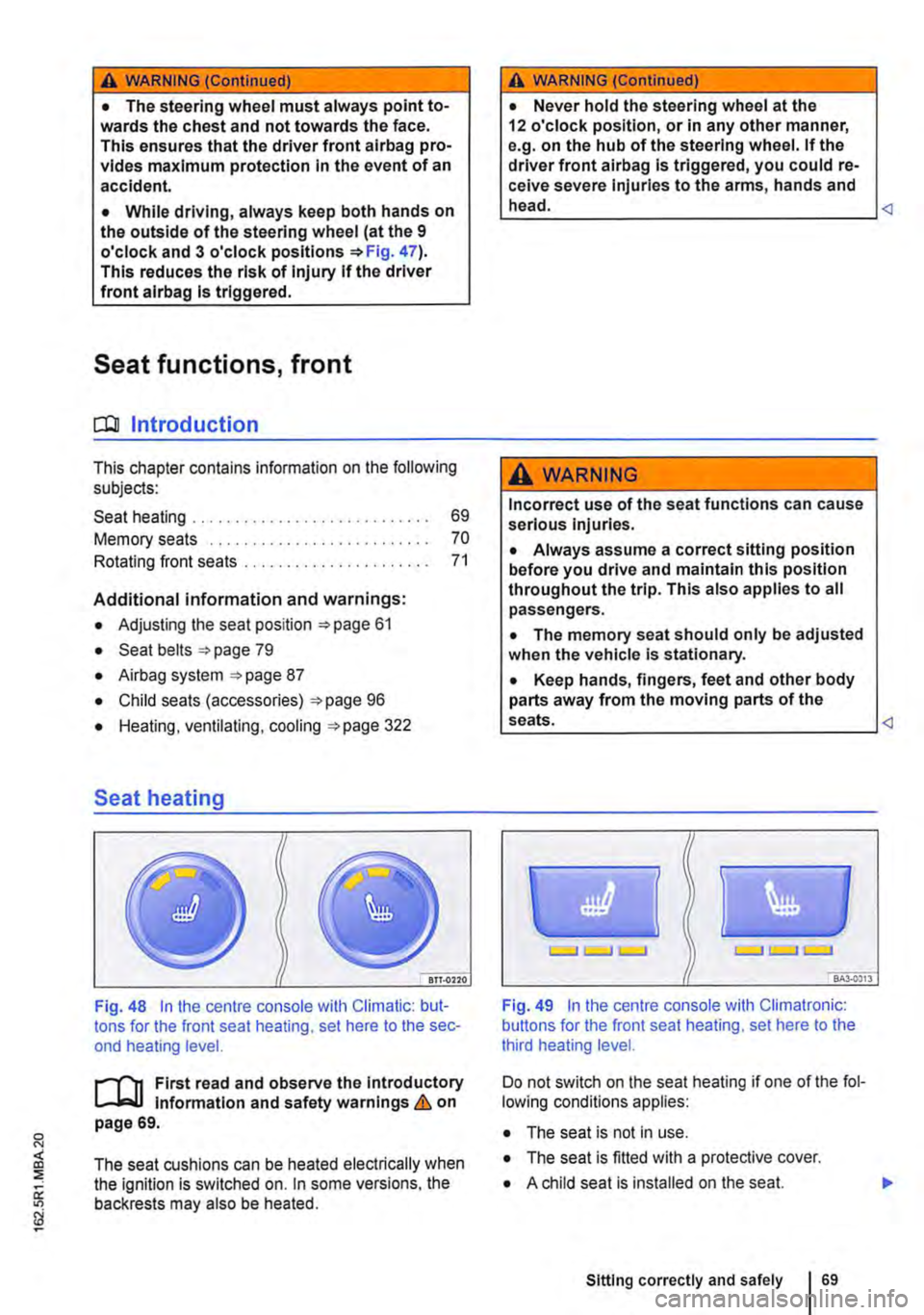
A WARNING (Continued)
• The steering wheel must always point to-wards the chest and not towards the face. This ensures that the driver front airbag pro-vides maximum protection in the event of an accident.
• While driving, always keep both hands on the outside of the steering wheel (at the 9 o'clock and 3 o'clock positions =>Fig. 47). This reduces the risk of injury if the driver front alrbag Is triggered.
Seat functions, front
a:n Introduction
This chapter contains information on the following subjects:
Seat heating . . . . . . . . . . . . . . . . . . . • • • . . . . . . 69
Memory seats . . . . . . . . . . . . . . . . . . . 70
Rotating front seats . . . . . . . . . . . . . . . . . . . . . . 71
Additional information and warnings:
• Adjusting the seat position =>page 61
• Seat bells =>page 79
• Airbag system =>page 87
• Child seats (accessories) 96
• Heating, ventilating, cooling 322
Seat heating
Fig. 48 In the centre console with Climatic: but-tons for the front seat heating, set here to the sec-ond heating level.
First read and observe the Introductory l-J,:.,U Information and safety warnings & on page 69.
The seat cushions can be heated electrically when the ignition is switched on. In some versions, the backrests may also be heated.
A WARNING (Continued)
• Never hold the steering wheel at the 12 o'clock position, or in any other manner, e.g. on the hub of the steering wheel. If the driver front airbag is triggered, you could re-ceive severe Injuries to the arms, hands and head.
A WARNING
Incorrect use of the seat functions can cause serious injuries.
• Always assume a correct sitting position before you drive and maintain this position throughout the trip. This also applies to all passengers.
• The memory seat should only be adjusted when the vehicle Is stationary.
• Keep hands, fingers, feet and other body parts away from the moving parts of the seats.
Fig. 49 In the centre console with Climatronic: buttons for the front seat heating, set here to the third heating level.
Do not switch on the seat heating if one of the fol-lowing conditions applies:
• The seat is not in use.
• The seat is fitted with a protective cover.
• A child seat is installed on the seat.
Sitting correctly and safely 69
Page 72 of 486
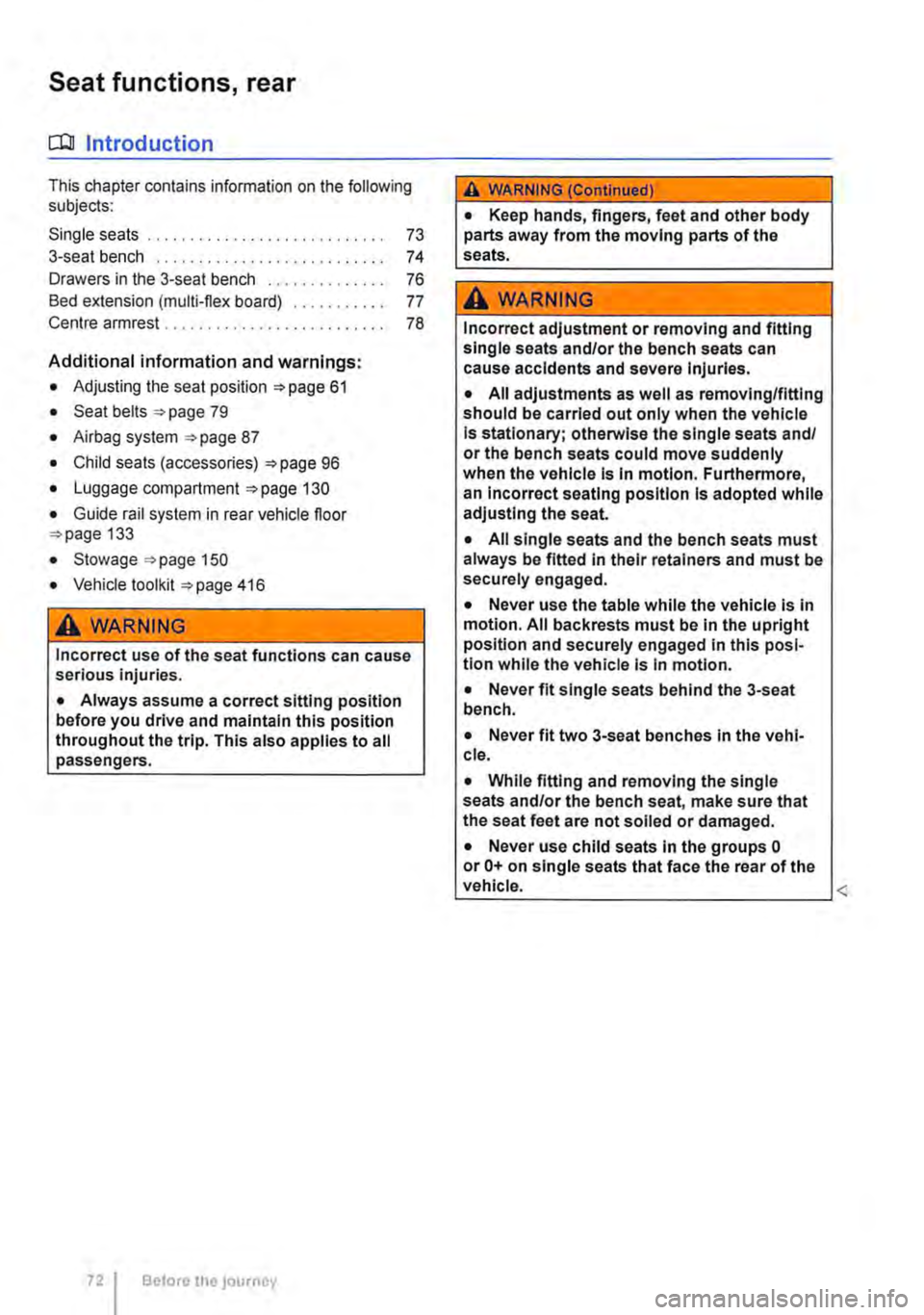
Seat functions, rear
Cl:lJ Introduction
This chapter contains information on the following subjects:
Single seats .
3-seat bench
Drawers in the 3-seat bench ......•.....
Bed extension (multi-flex board) ... Centre armrest ......................... .
Additional information and warnings:
• Adjusting the seat position 61
• Seat belts ""page 79
• Airbag system 87
• Child seats (accessories) :;.page 96
• Luggage compartment :;. page 130
• Guide rail system in rear vehicle floor :;.page 133
• Stowage ""page 150
• Vehicle tool kit ""page 416
A WARNING
73
74
76
77 78
Incorrect use of the seat functions can cause serious injuries.
• Always assume a correct sitting position before you drive and maintain this position throughout the trip. This also applies to all passengers.
721 Before the journey
A WARNING (Continued)
• Keep hands, fingers, feet and other body parts away from the moving parts of the seats.
A WARNING
Incorrect adjustment or removing and fitting single seats and/or the bench seats can cause accidents and severe Injuries.
• All adjustments as well as removing/fitting should be carried out only when the vehicle is stationary; otherwise the single seats and/ or the bench seats could move suddenly when the vehicle Is In motion. Furthermore, an Incorrect seating position Is adopted while adjusting the seat.
• All single seats and the bench seats must always be fitted In their retainers and must be securely engaged.
• Never use the table while the vehicle is In motion. All backrests must be In the upright position and securely engaged in this posi-tion while the vehicle Is In motion.
• Never fit single seats behind the 3-seat bench.
• Never fit two 3-seat benches In the vehi-cle.
• While fitting and removing the single seats and/or the bench seat, make sure that the seat feet are not soiled or damaged.
• Never use child seats In the groups 0 or 0+ on single seats that face the rear of the vehicle. <
Page 79 of 486
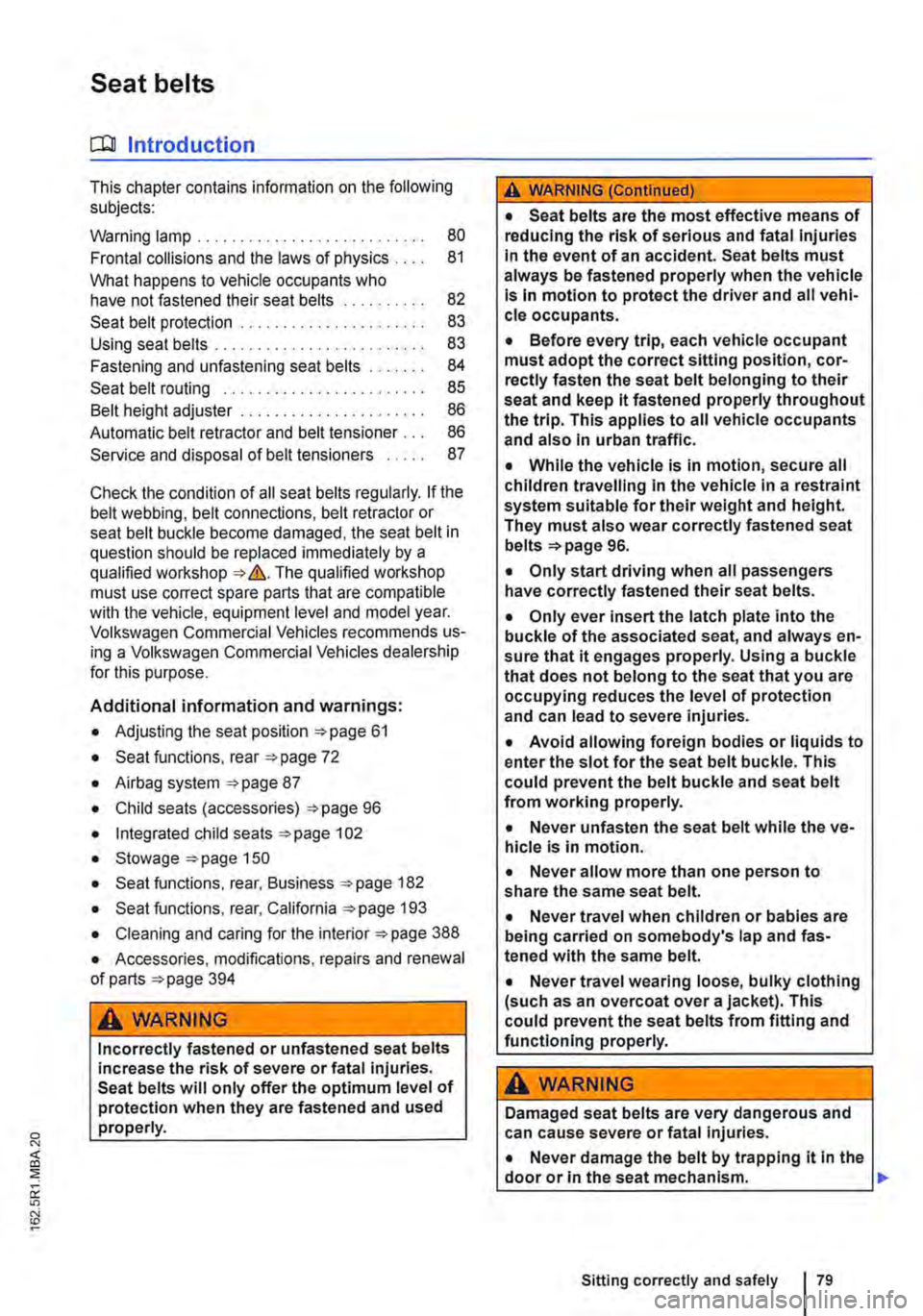
Seat belts
o:n Introduction
This chapter contains information on the following subjects:
Warning lamp . . . . . . . . . . . 80
Frontal collisions and the laws of physics 81
What happens to vehicle occupants who have not fastened their seat belts 82
Seat belt protection . . . . . . . . . . . . . . . . . . . . . . 83 Using seat belts . . . . . . . . . . . . . . 83
Fastening and unfastening seat belts . 84 Seat belt routing . . . . . . . . . . . . . . . . . . 85
Belt height adjuster . . . . . . . . . . . . . . . . 86
Automatic belt retractor and belt tensioner . . . 86
Service and disposal of belt tensioners . . 87
Check the condition of all seat belts regularly. If the belt webbing, belt connections, belt retractor or seat belt buckle become damaged, the seat belt in question should be replaced immediately by a qualified workshop=:.&. The qualified workshop must use correct spare parts that are compatible with the vehicle, equipment level and model year. Volkswagen Commercial Vehicles recommends us-ing a Volkswagen Commercial Vehicles dealership for this purpose.
Additional information and warnings:
• Adjusting the seat position =:.page 61
• Seat functions, rear =>page 72
• Airbag system =>page 87
• Child seats (accessories) =:.page 96
• Integrated child seats =:.page 102
• Stowage =>page 150
• Seat functions, rear, Business =>page 182
• Seat functions, rear, California =:.page 193
• Cleaning and caring for the interior =:.page 388
• Accessories, modifications, repairs and renewal of parts =>page 394
A WARNING
Incorrectly fastened or unfastened seat belts increase the risk of severe or fatal injuries. Seat belts will only offer the optimum level of protection when they are fastened and used properly.
A WARNING (Continued)
• Seat belts are the most effective means of reducing the risk of serious and fatal injuries In the event of an accident. Seat belts must always be fastened properly when the vehicle Is In motion to protect the driver and all vehi-cle occupants.
• Before every trip, each vehicle occupant must adopt the correct sitting position, cor-rectly fasten the seat belt belonging to their seat and keep it fastened properly throughout the trip. This applies to all vehicle occupants and also In urban traffic.
• While the vehicle is in motion, secure all children travelling In the vehicle in a restraint system suitable for their weight and height. They must also wear correctly fastened seat belts =>page 96.
• Only start driving when all passengers have correctly fastened their seat belts.
• Only ever insert the latch plate into the buckle of the associated seat, and always en-sure that it engages properly. Using a buckle that does not belong to the seat that you are occupying reduces the level of protection and can lead to severe injuries.
• Avoid allowing foreign bodies or liquids to enter the slot for the seat belt buckle. This could prevent the belt buckle and seat belt from working properly.
• Never unfasten the seat belt while the ve-hicle is in motion.
• Never allow more than one person to share the same seat belt.
• Never travel when children or babies are being carried on somebody's lap and fas-tened with the same belt.
• Never travel wearing loose, bulky clothing (such as an overcoat over a jacket). This could prevent the seat belts from fitting and functioning properly.
A WARNING
Damaged seat belts are very dangerous and can cause severe or fatal Injuries.
• Never damage the belt by trapping it in the door or in the seat mechanism. 11>
Sitting correctly and safely
Page 82 of 486
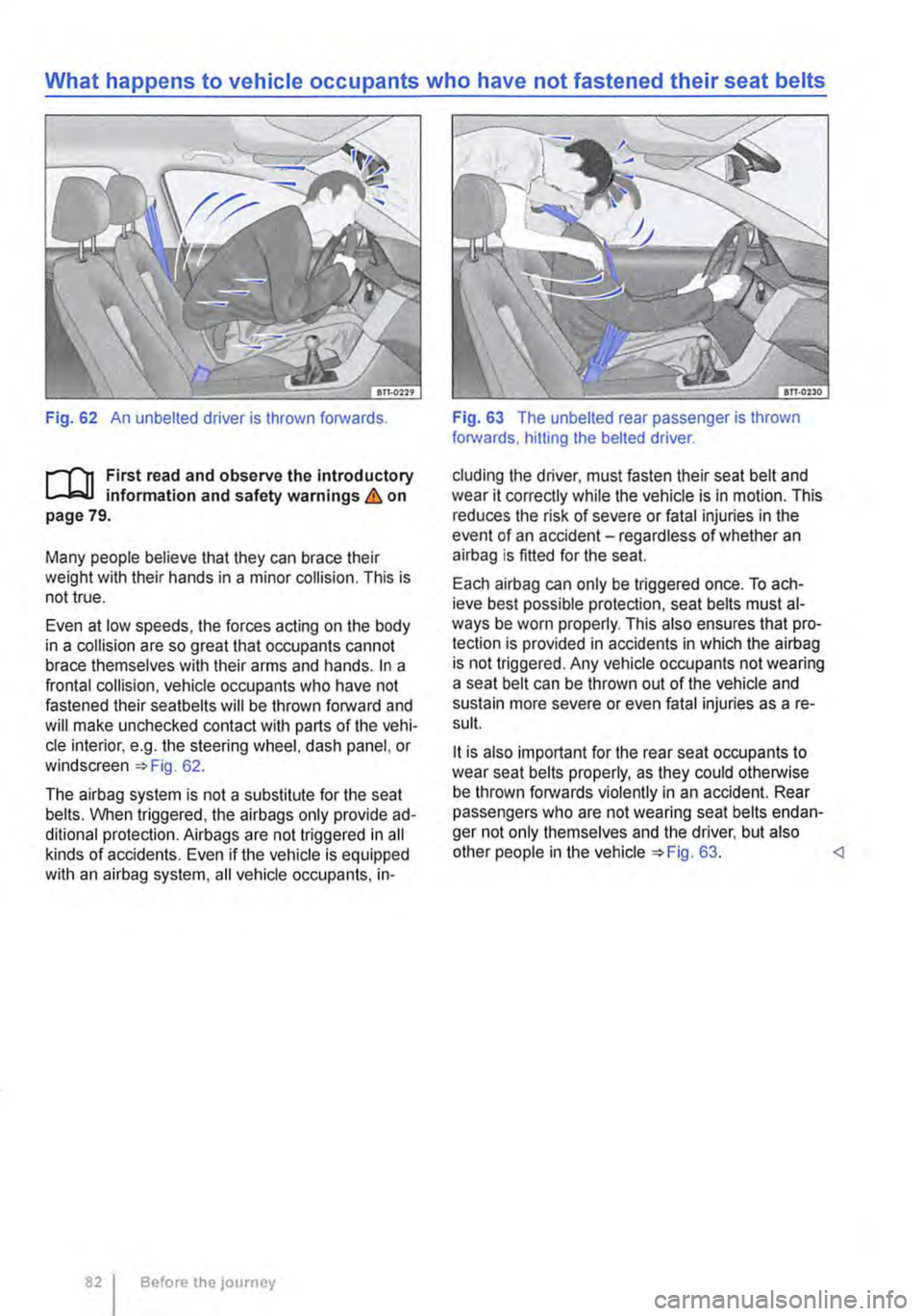
Fig. 62 An unbelted driver is thrown forwards.
r--()1 First read and observe the introductory L-.lo:-U information and safety warnings & on page 79.
Many people believe that they can brace their weight with their hands in a minor collision. This is not true.
Even at low speeds, the forces acting on the body in a collision are so great that occupants cannot brace themselves with their arms and hands. In a frontal collision, vehicle occupants who have not fastened their seatbelts will be thrown forward and will make unchecked contact with parts of the vehi-cle interior, e.g. the steering wheel, dash panel, or windscreen =:-Fig. 62.
The airbag system is not a substitute for the seat belts. When triggered, the airbags only provide ad-ditional protection. Airbags are not triggered in all kinds of accidents. Even if the vehicle is equipped with an airbag system, all vehicle occupants, in-
Before the Journey
Fig. 63 The unbelted rear passenger is thrown forwards, hitting the belted driver.
eluding the driver, must fasten their seat belt and wear it correctly while the vehicle is in motion. This reduces the risk of severe or fatal injuries in the event of an accident-regardless of whether an airbag is fitted for the seat.
Each airbag can only be triggered once. To ach-ieve best possible protection, seat belts must al-ways be worn properly. This also ensures that pro-tection is provided in accidents in which the airbag is not triggered. Any vehicle occupants not wearing a seat belt can be thrown out of the vehicle and sustain more severe or even fatal injuries as a re-sult.
11 is also important for the rear seat occupants to wear seat belts properly, as they could otherwise be thrown forwards violently in an accident. Rear passengers who are not wearing seat belts endan-ger not only themselves and the driver, but also other people in the vehicle =:-Fig. 63.
Page 83 of 486
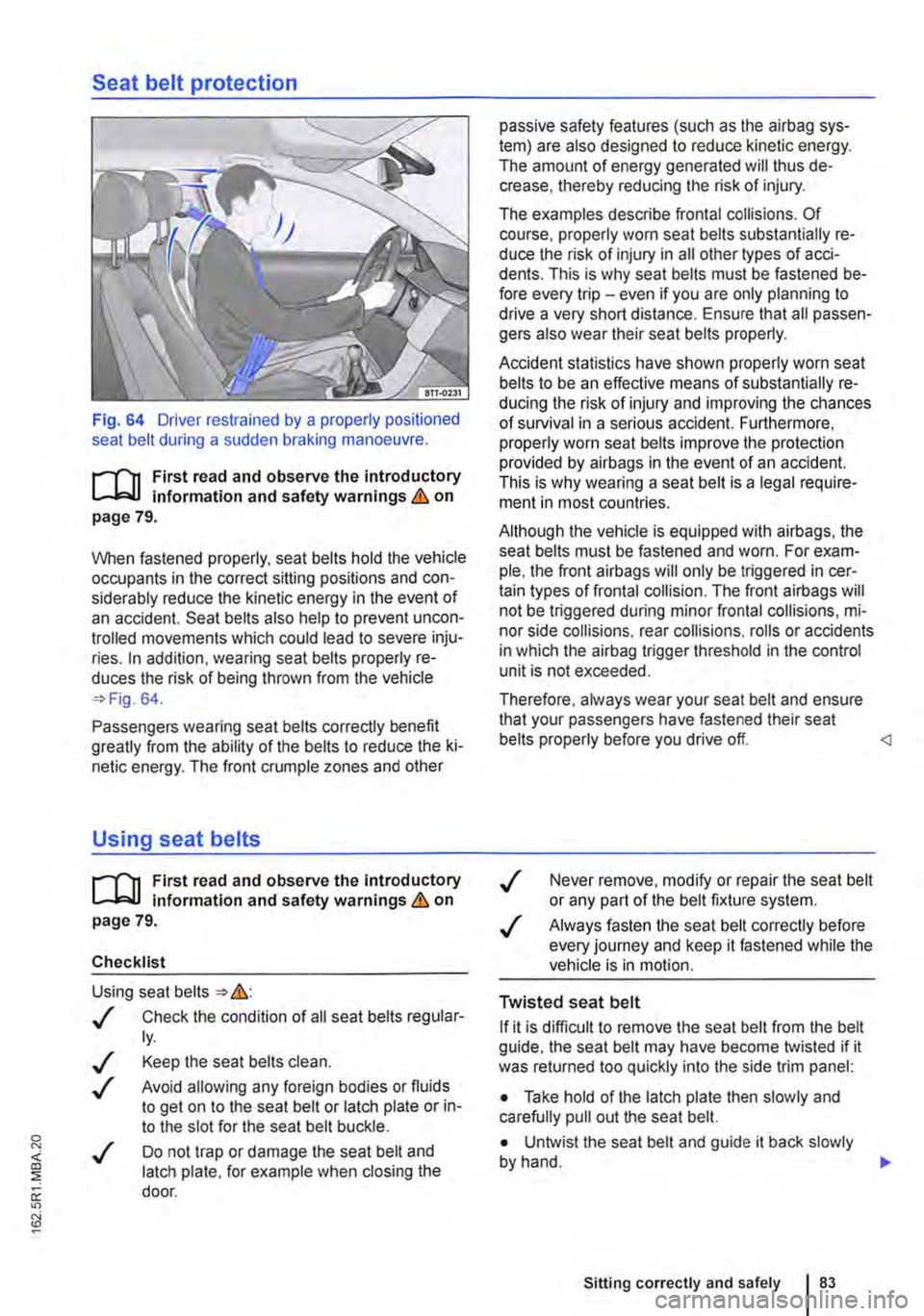
Seat belt protection
Fig. 64 Driver restrained by a properly positioned seat belt during a sudden braking manoeuvre.
i"111 First read and observe the introductory L..-.lo:.U information and safety warnings & on page 79.
When fastened properly, seat belts hold the vehicle occupants in the correct sitting positions and con-siderably reduce the kinetic energy in the event of an accident. Seat belts also help to prevent uncon-trolled movements which could lead to severe inju-ries. In addition, wearing seat belts properly re-duces the risk of being thrown from the vehicle 64.
Passengers wearing seat belts correctly benefit greatly from the ability of the belts to reduce the ki-netic energy. The front crumple zones and other
Using seat belts
i"111 First read and observe the Introductory L..-.lo:.U Information and safety warnings & on page 79.
Checklist
Using seat belts &:
../ Check the condition of all seat belts regular-ly.
../
../
Keep the seat belts clean.
Avoid allowing any foreign bodies or fluids to get on to the seat belt or latch plate or in-to the slot for the seat belt buckle.
../ Do not trap or damage the seat belt and latch plate. for example when closing the door.
passive safety features (such as the airbag sys-tem) are also designed to reduce kinetic energy. The amount of energy generated will thus de-crease, thereby reducing the risk of injury.
The examples describe frontal collisions. Of course, properly worn seat belts substantially re-duce the risk of injury in all other types of acci-dents. This is why seat belts must be fastened be-fore every trip -even if you are only planning to drive a very short distance. Ensure that all passen-gers also wear their seat belts properly.
Accident statistics have shown properly worn seat belts to be an effective means of substantially re-ducing the risk of injury and improving the chances of survival in a serious accident. Furthermore, properly worn seat belts improve the protection provided by airbags in the event of an accident. This is why wearing a seat belt is a legal require-ment in most countries.
Although the vehicle is equipped with airbags, the seat belts must be fastened and worn. For exam-ple, the front airbags will only be triggered in cer-tain types of frontal collision. The front airbags will not be triggered during minor frontal collisions, mi-nor side collisions, rear collisions. rolls or accidents in which the airbag trigger threshold in the control unit is not exceeded.
Therefore. always wear your seat belt and ensure that your passengers have fastened their seat belts properly before you drive off.
../ Always fasten the seat belt correctly before every journey and keep it fastened while the vehicle is in motion.
Twisted seat belt
If it is difficult to remove the seat belt from the belt guide, the seat belt may have become twisted if it was returned too quickly into the side trim panel:
• Take hold of the latch plate then slowly and carefully pull out the seat belt.
• Untwist the seat belt and guide it back slowly
Sitting correctly and safely
Page 85 of 486
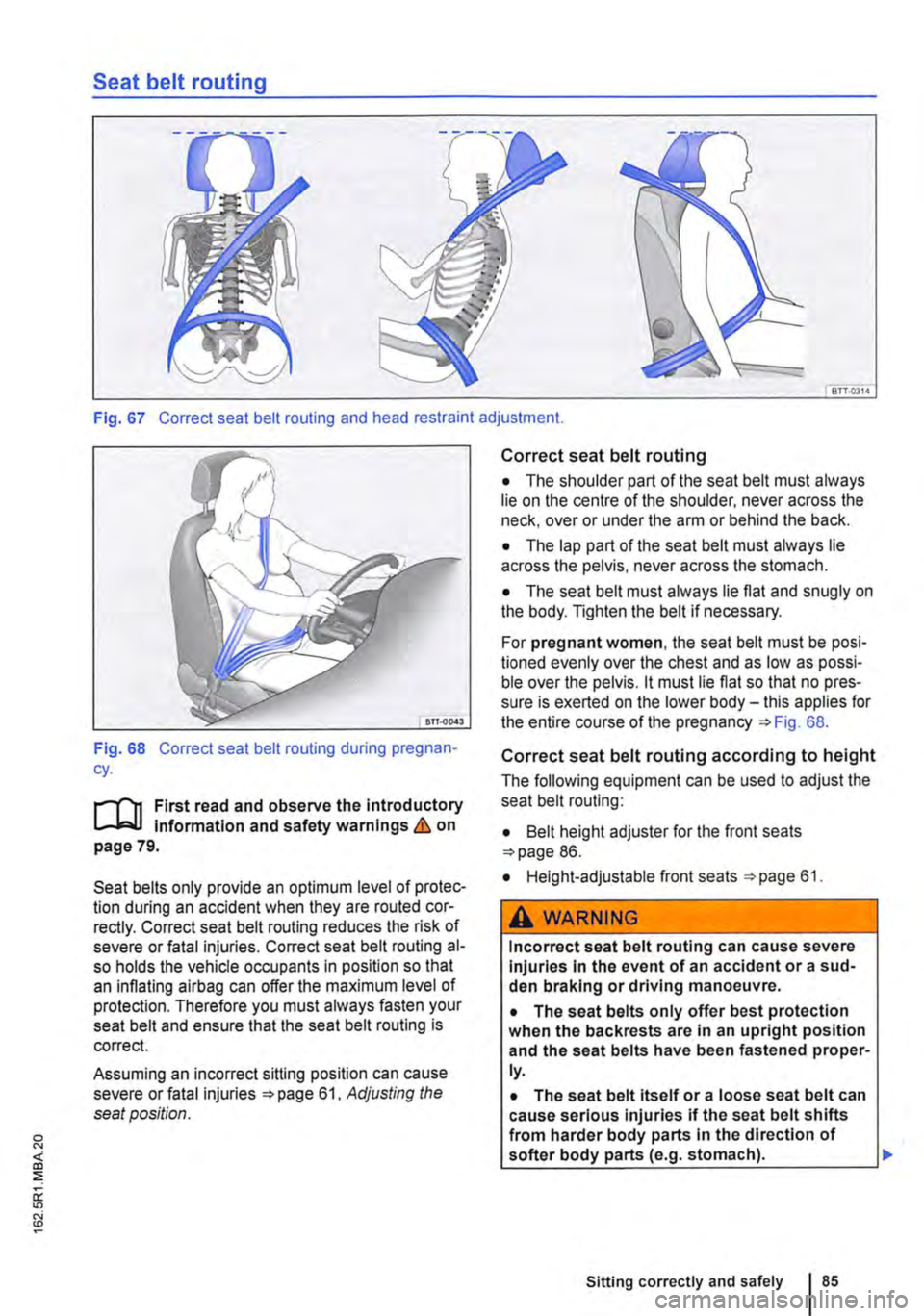
Seat belt routing
BTT.Q3l4
Fig. 67 Correct seat belt routing and head restraint adjustment.
Fig. 68 Correct seat belt routing during pregnan-cy.
r-T'n First read and observe the introductory L-Wl infonmation and safety warnings & on page 79.
Seat belts only provide an optimum level of protec-tion during an accident when they are routed cor-rectly. Correct seat belt routing reduces the risk of severe or fatal injuries. Correct seat belt routing al-so holds the vehicle occupants in position so that an inflating airbag can offer the maximum level of protection. Therefore you must always fasten your seat belt and ensure that the seat belt routing is correct.
Assuming an incorrect sitting position can cause severe or fatal injuries 61, Adjusting the seat position.
Correct seat belt routing
• The shoulder part of the seat belt must always lie on the centre of the shoulder, never across the neck, over or under the arm or behind the back.
• The lap part of the seat belt must always lie across the pelvis, never across the stomach.
• The seat belt must always lie flat and snugly on the body. Tighten the belt if necessary.
For pregnant women, the seat belt must be posi-tioned evenly over the chest and as low as possi-ble over the pelvis. it must lie flat so that no pres-sure is exerted on the lower body-this applies for the entire course of the pregnancy =>Fig. 68.
Correct seat belt routing according to height
The following equipment can be used to adjust the seat belt routing:
• Belt height adjuster for the front seats =>page 86.
• Height-adjustable front seats =>page 61.
A WARNING
Incorrect seat belt routing can cause severe Injuries In the event of an accident or a sud-den braking or driving manoeuvre.
• The seat belts only offer best protection when the backrests are in an upright position and the seat belts have been fastened proper-ly.
• The seat belt itself or a loose seat belt can cause serious injuries if the seat belt shifts from harder body parts In the direction of softer body parts (e.g. stomach). .,.
Sitting correctly and safely
Page 86 of 486
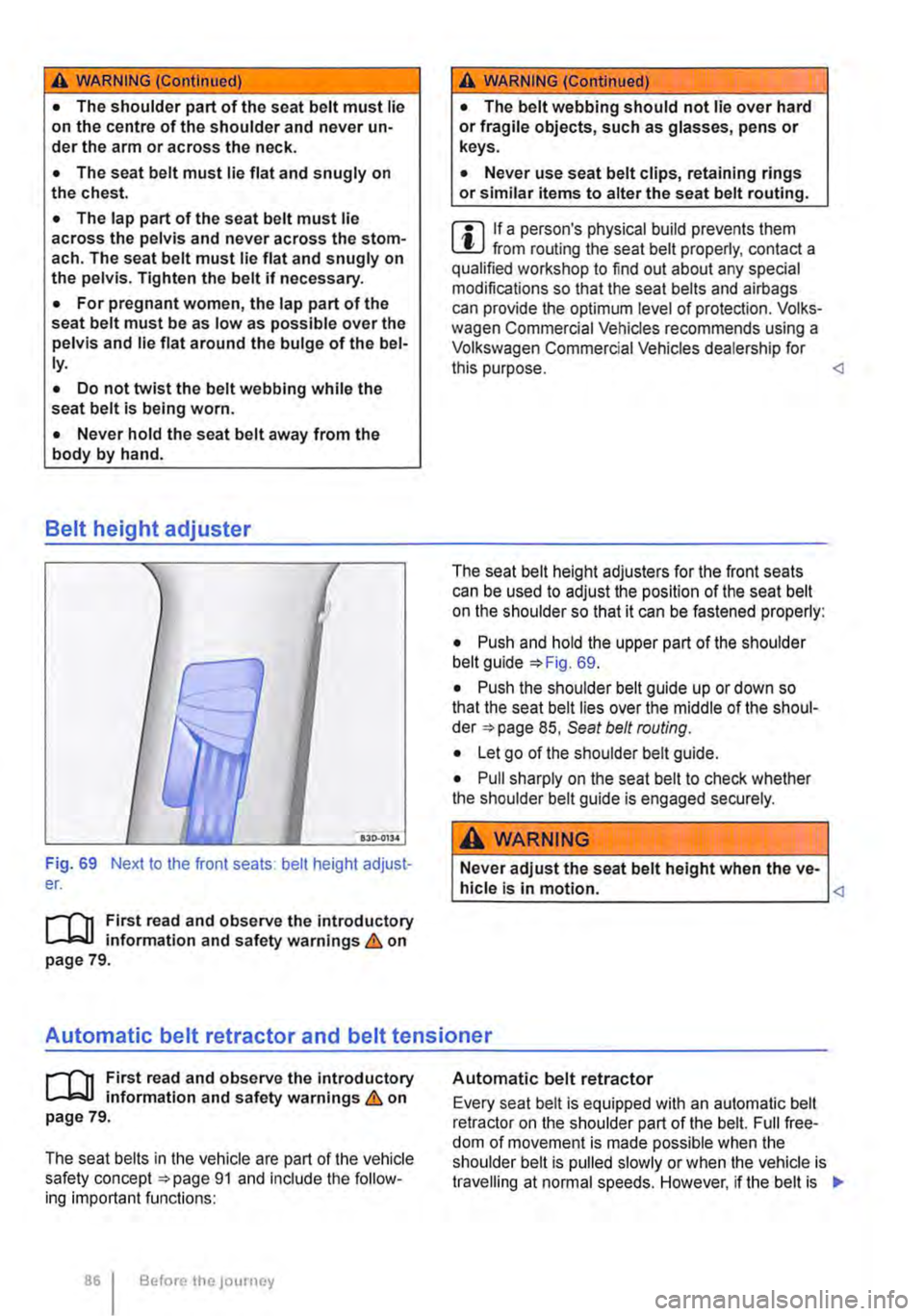
A WARNING !Continued)
• The shoulder part of the seat belt must lie on the centre of the shoulder and never un-der the arm or across the neck.
• The seat belt must lie flat and snugly on the chest.
• The lap part of the seat belt must lie across the pelvis and never across the stom-ach. The seat belt must lie flat and snugly on the pelvis. Tighten the belt if necessary.
• For pregnant women, the lap part of the seat belt must be as low as possible over the pelvis and lie flat around the bulge of the bel-ly.
• Do not twist the belt webbing while the seat belt is being worn.
• Never hold the seat belt away from the body by hand.
Belt height adjuster
Fig. 69 Next to the front seats: belt height adjust-er.
r--T'n First read and observe the introductory L-W.I information and safety warnings & on page 79.
A WARNING !Continued)
• The belt webbing should not lie over hard or fragile objects, such as glasses, pens or keys.
• Never use seat belt clips, retaining rings or similar items to alter the seat belt routing.
m If a person's physical build prevents them L.!:J from routing the seat belt properly, contact a qualified workshop to find out about any special modifications so that the seat bells and airbags can provide the optimum level of protection. Volks-wagen Commercial Vehicles recommends using a Volkswagen Commercial Vehicles dealership for this purpose.
• Push and hold the upper part of the shoulder belt guide 69.
• Push the shoulder belt guide up or down so that the seat belt lies over the middle of the shoul-der 85, Seat belt routing.
• Let go of the shoulder belt guide.
• Pull sharply on the seat bell to check whether the shoulder belt guide is engaged securely.
Never adjust the seat belt height when the ve-hicle is in motion.
r--f"'n First read and observe the introductory L-W.I information and safety warnings & on page 79.
The seat belts in the vehicle are part of the vehicle safety concept 91 and include the follow-ing important functions:
86 Before the journey
Automatic belt retractor
Every seat belt is equipped with an automatic belt retractor on the shoulder part of the belt. Full free-dom of movement is made possible when the shoulder belt is pulled slowly or when the vehicle is travelling at normal speeds. However, if the belt is IIJ>
Page 87 of 486
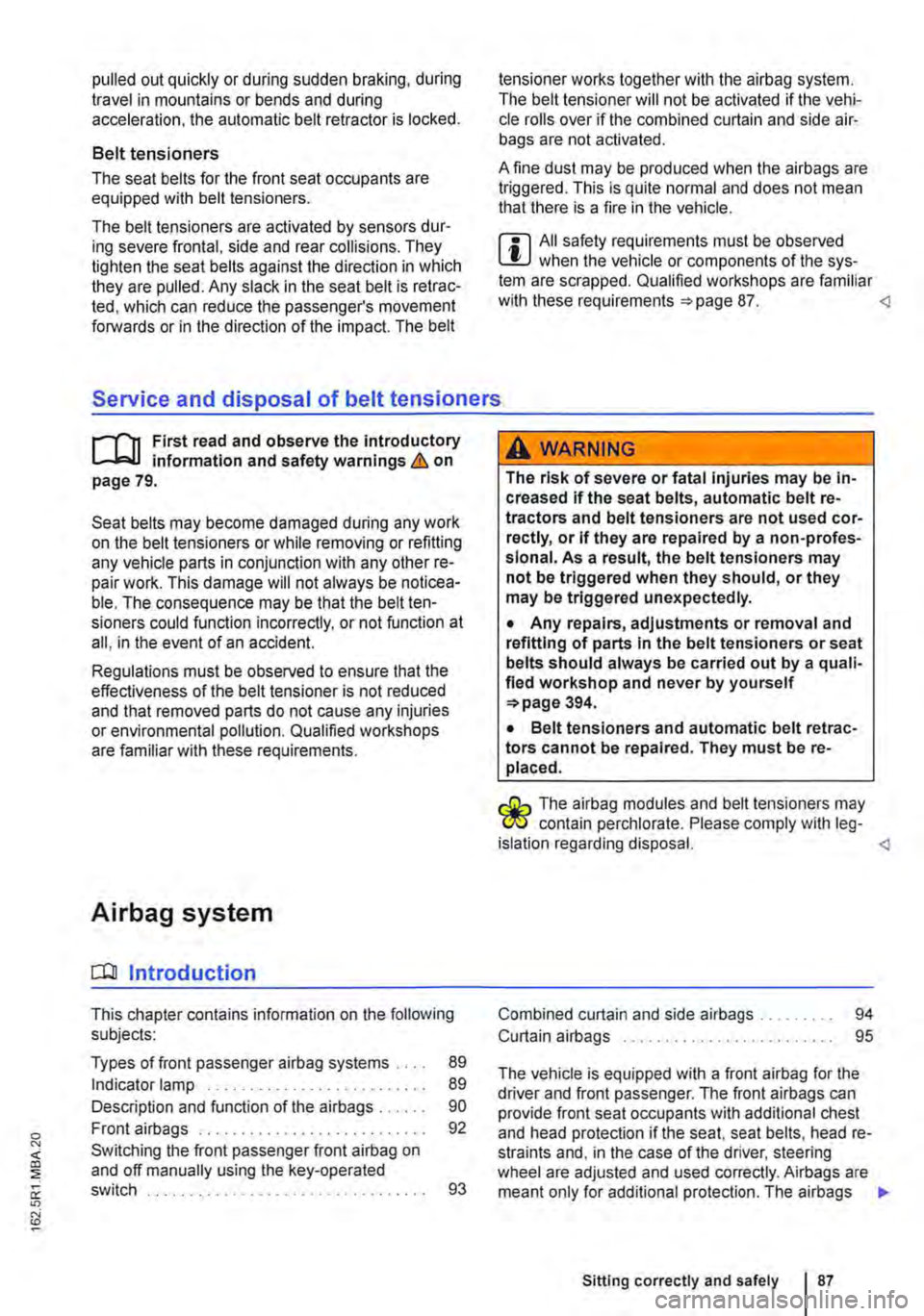
pulled out quickly or during sudden braking, during travel in mountains or bends and during acceleration, the automatic belt retractor is locked.
Belt tensioners
The seat belts for the front seat occupants are equipped with belt tensioners.
The belt tensioners are activated by sensors dur-ing severe frontal, side and rear collisions. They tighten the seat belts against the direction in which they are pulled. Any slack in the seat belt is retrac-ted, which can reduce the passenger's movement forwards or in the direction of the impact. The belt
tensioner works together with the airbag system. The belt tensioner will not be activated if the vehi-cle rolls over if the combined curtain and side air-bags are not activated.
A fine dust may be produced when the airbags are triggered. This is quite normal and does not mean that there is a fire in the vehicle.
W All safety requirements must be observed L!.J when the vehicle or components of the sys-tem are scrapped. Qualified workshops are familiar with these requirements 87.
r-f'n First read and observe the introductory L-J,:.U information and safety warnings & on page 79.
Seat belts may become damaged during any work on the belt tensioners or while removing or refitting any vehicle parts in conjunction with any other re-pair work. This damage will not always be noticea-ble. The consequence may be that the belt ten-sioners could function incorrectly, or not function at all, in the event of an accident.
Regulations must be observed to ensure that the effectiveness of the belt tensioner is not reduced and that removed parts do not cause any injuries or environmental pollution. Qualified workshops are familiar with these requirements.
Airbag system
o:lJ Introduction
This chapter contains information on the following subjects:
Types of front passenger airbag systems . . . . 89
Indicator lamp . . . . . . . . . . . . . . . . . . . 89
Description and function of the airbags 90 Front airbags 92 Switching the front passenger front airbag on and off manually using the key-operated switch . . . 93
A WARNING
The risk of severe or fatal injuries may be in-creased if the seat belts, automatic belt re-tractors and belt tensioners are not used cor-rectly, or if they are repaired by a non-profes-sional. As a result, the belt tensioners may not be triggered when they should, or they may be triggered unexpectedly.
• Any repairs, adjustments or removal and refitting of parts in the belt tensioners or seat belts should always be carried out by a quali-fied workshop and never by yourself 394.
• Belt tensioners and automatic belt retrac-tors cannot be repaired. They must be re-placed.
r:Gl:-. The airbag modules and belt tensioners may C!fS contain perchlorate. Please comply with leg-islation regarding disposal.
Curtain airbags . . . . . . . . . . . . . . . . . . . . . . . . . 95
The vehicle is equipped with a front airbag for the driver and front passenger. The front airbags can provide front seat occupants with additional chest and head protection if the seat, seat belts, head re-straints and, in the case of the driver, steering wheel are adjusted and used correctly. Airbags are meant only for additional protection. The airbags .,.
Sitting correctly and safely 87
Page 88 of 486
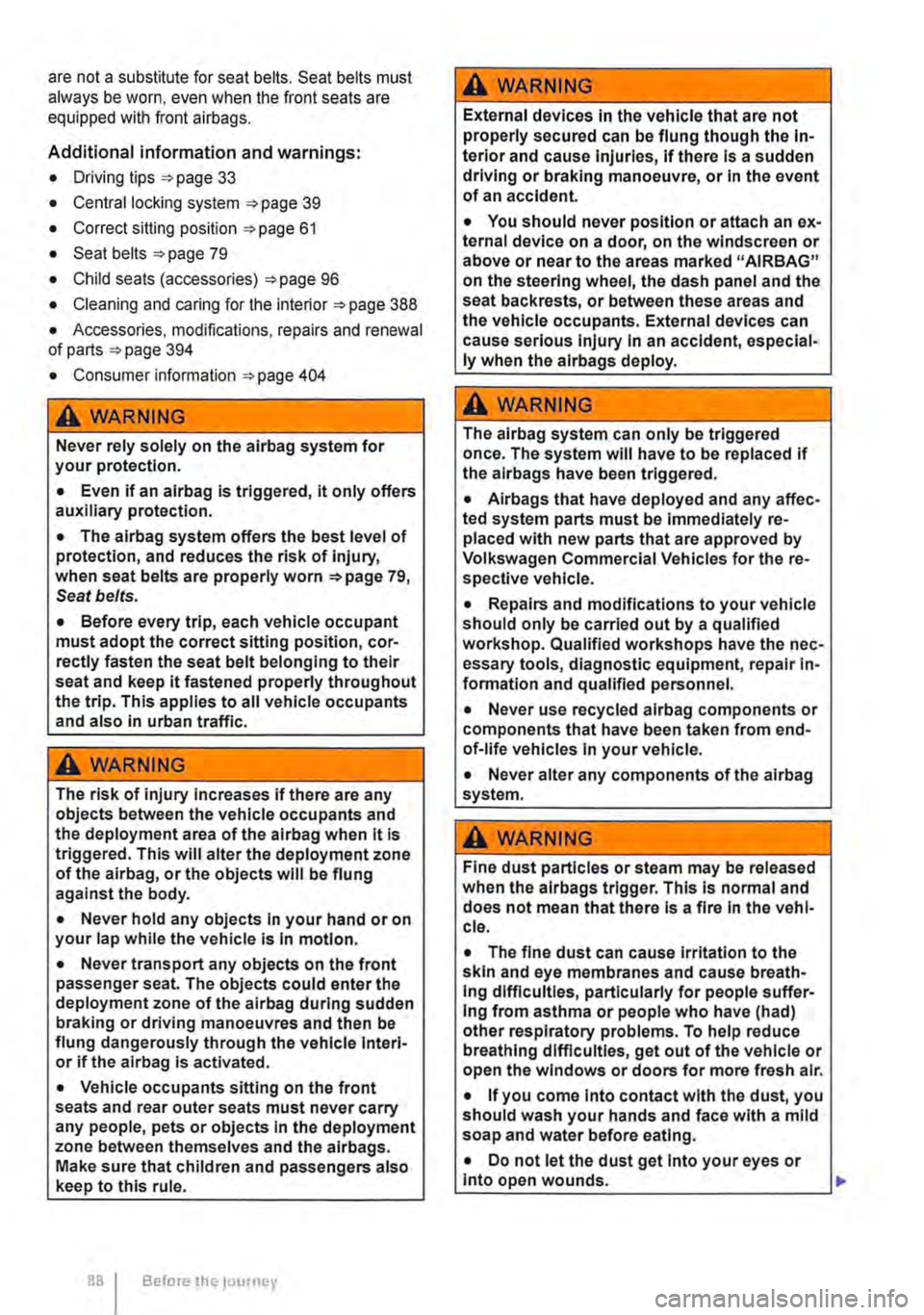
are not a substitute for seat belts. Seat belts must always be worn, even when the front seats are equipped with front airbags.
Additional information and warnings:
• Driving tips 33
• Central locking system 39
• Correct sitting position 61
• Seat belts 79
• Child seats (accessories) 96
• Cleaning and caring for the interior 388
• Accessories, modifications, repairs and renewal of parts 394
• Consumer information 404
A WARNING
Never rely solely on the airbag system for your protection.
• Even if an alrbag is triggered, it only offers auxiliary protection.
• The airbag system offers the best level of protection, and reduces the risk of injury, when seat belts are properly worn 79, Seat belts.
• Before every trip, each vehicle occupant must adopt the correct sitting position, cor-rectly fasten the seat belt belonging to their seat and keep it fastened properly throughout the trip. This applies to ail vehicle occupants and also in urban traffic.
A WARNING
The risk of injury increases if there are any objects between the vehicle occupants and the deployment area of the airbag when it is triggered. This will alter the deployment zone of the airbag, or the objects will be flung against the body.
• Never hold any objects in your hand or on your lap while the vehicle is in motion.
• Never transport any objects on the front passenger seal The objects could enter the deployment zone of the airbag during sudden braking or driving manoeuvres and then be flung dangerously through the vehicle interi-or if the airbag is activated.
• Vehicle occupants sitting on the front seats and rear outer seats must never carry any people, pets or objects in the deployment zone between themselves and the airbags. Make sure that children and passengers also keep to this rule.
BB I Before the journey
A WARNING
External devices in the vehicle that are not properly secured can be flung though the in-terior and cause injuries, if there is a sudden driving or braking manoeuvre, or in the event of an accident.
• You should never position or attach an ex-ternal device on a door, on the windscreen or above or near to the areas marked "AIRBAG" on the steering wheel, the dash panel and the seat backrests, or between these areas and the vehicle occupants. External devices can cause serious Injury in an accident, especial-ly when the airbags deploy.
A WARNING
The alrbag system can only be triggered once. The system will have to be replaced if the airbags have been triggered.
• Alrbags that have deployed and any affec-ted system parts must be immediately re-placed with new parts that are approved by Volkswagen Commercial Vehicles for the re-spective vehicle.
• Repairs and modifications to your vehicle should only be carried out by a qualified workshop. Qualified workshops have the nec-essary tools, diagnostic equipment, repair in-formation and qualified personnel.
• Never use recycled alrbag components or components that have been taken from end-of-life vehicles in your vehicle.
• Never alter any components of the airbag system.
A WARNING
Fine dust particles or steam may be released when the alrbags trigger. This Is normal and does not mean that there is a fire in the vehi-cle.
• The fine dust can cause irritation to the skin and eye membranes and cause breath-ing difficulties, particularly for people suffer-ing from asthma or people who have {had) other respiratory problems. To help reduce breathing difficulties, get out of the vehicle or open the windows or doors for more fresh air.
• If you come into contact with the dust, you should wash your hands and face with a mild soap and water before eating.
• Do not let the dust get into your eyes or into open wounds.
Page 89 of 486
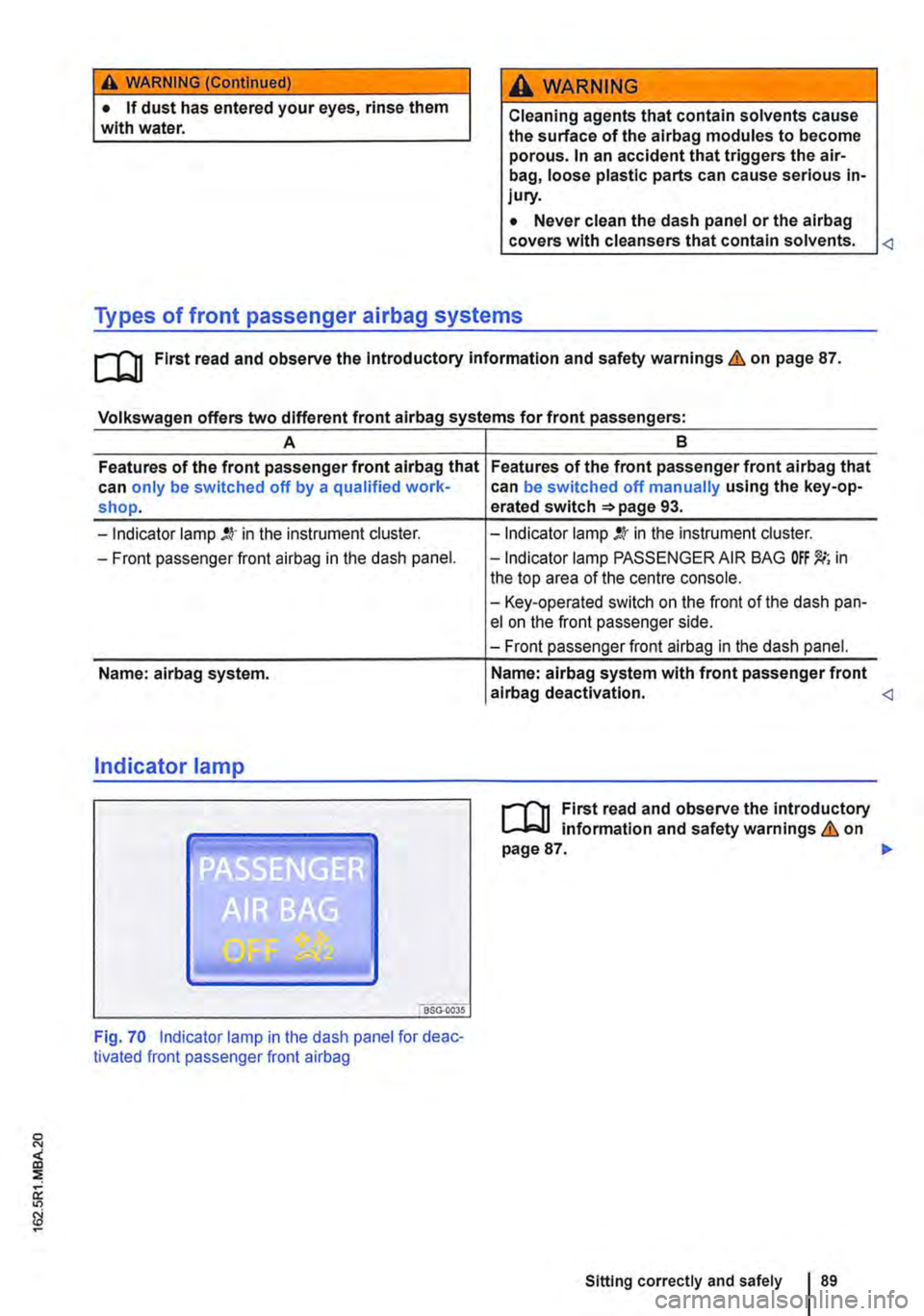
A WARNING (Continued)
• If dust has entered your eyes, rinse them with water.
A WARNING
Cleaning agents that contain solvents cause the surface of the alrbag modules to become porous. In an accident that triggers the air-bag, loose plastic parts can cause serious In-jury.
• Never clean the dash panel or the airbag covers with cleansers that contain solvents.
CQI First read and observe the introductory information and safety warnings & on page 87.
Volkswagen offers two different front airbag systems for front passengers:
A 8
Features of the front passenger front airbag that Features of the front passenger front airbag that can only be switched off by a qualified work-can be switched off manually using the key-op-shop. erated switch =>page 93.
-Indicator lamp in the instrument cluster.
-Front passenger front airbag in the dash panel.
Name: airbag system.
Indicator lamp
"'iSG."oo3s
Fig. 70 Indicator lamp in the dash panel for deac-tivated front passenger front airbag
-Indicator lamp !.lr in the instrument cluster.
-Indicator lamp PASSENGER AIR BAG in the top area of the centre console.
-Key-operated switch on the front of the dash pan-el on the front passenger side.
-Front passenger front airbag in the dash panel.
Name: airbag system with front passenger front alrbag deactivation. <1
r-f"'n First read and observe the introductory l.-.lo:-l.l information and safety warnings & on page 87. .,.
Sitting correctly and safely 89